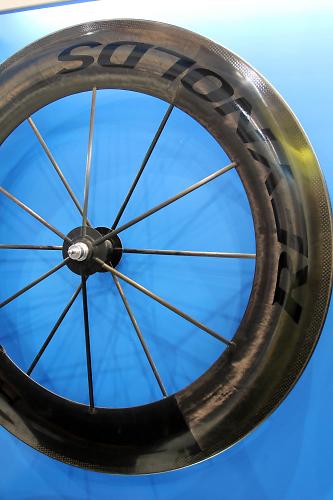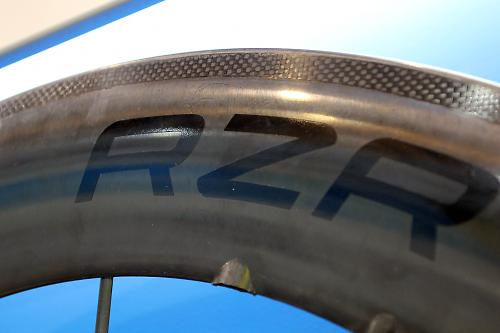- News
- Reviews
- Bikes
- Components
- Bar tape & grips
- Bottom brackets
- Brake & gear cables
- Brake & STI levers
- Brake pads & spares
- Brakes
- Cassettes & freewheels
- Chains
- Chainsets & chainrings
- Derailleurs - front
- Derailleurs - rear
- Forks
- Gear levers & shifters
- Groupsets
- Handlebars & extensions
- Headsets
- Hubs
- Inner tubes
- Pedals
- Quick releases & skewers
- Saddles
- Seatposts
- Stems
- Wheels
- Tyres
- Tubeless valves
- Accessories
- Accessories - misc
- Computer mounts
- Bags
- Bar ends
- Bike bags & cases
- Bottle cages
- Bottles
- Cameras
- Car racks
- Child seats
- Computers
- Glasses
- GPS units
- Helmets
- Lights - front
- Lights - rear
- Lights - sets
- Locks
- Mirrors
- Mudguards
- Racks
- Pumps & CO2 inflators
- Puncture kits
- Reflectives
- Smart watches
- Stands and racks
- Trailers
- Clothing
- Health, fitness and nutrition
- Tools and workshop
- Miscellaneous
- Buyers Guides
- Features
- Forum
- Recommends
- Podcast
news
 Paul Lew 1.jpg
Paul Lew 1.jpgWheel wisdom: Get aero with Paul Lew +video
According to Reynolds, their RZR 92s are the most technologically superior bike wheels ever made. They come with a completely new rim shape, an innovative 'torque flange' on the rear hub and a host of other features designed to push the performance beyond that of anything else out there. We spoke to Paul Lew, the man who invented them, about what makes the RZRs so fast.
If you don’t know, Paul Lew is a former pro triathlete, an aero expert and a composites engineer – a genuine big cheese in the world of bicycle design. He set up Lew Racing and is now consultant to Reynolds Cycling, and when he’s not reinventing the bike wheel he’s working on unmanned aircraft for the US government – drones, to you and me.
We reviewed the RZR 46s on road.cc last year and it’s fair to say that they blew us away. They’re so light it’s almost unbelievable – under 900g for the pair – and incredibly fast. Check out the review for the details. The 46 refers to the rim depth in millimetres. They also come in a 92mm version where the rims are, to be precise, 91.55mm deep. We started by discussing the design process…
Reynolds develop everything on the computer using their Computational Fluid Dynamics program, the algorithms based on masses of data. So, rather than having to shoulder the time and expense of building every design and then seeing how it performs in the tunnel, they design it and test it on the computer. Lew is very insistent on that: they test it on the computer. Yes, they take it to the tunnel afterwards, but that’s “For validation rather than testing”. They already know how it will perform aerodynamically, pretty much; the computer is usually correct to within 1-1.5%.
Interestingly, it’s the tyre that’s more often than not responsible for any variations between the computer data and the wind tunnel data. Tyres can’t be manufactured to the same degree of accuracy as a carbon fibre wheel, so they’re less predictable.
The RZR is chock-full of technical innovation, but the most important is the shape of the rim. Whereas Zipp have gone for a broad spoke face with their Firecrest design, Lew has designed a much more tapered profile with a sharp spoke face. It’s a very different approach.
Lew’s aim is to keep the airflow as smooth and calm as possible. “Turbulence begets turbulence,” he says. In other words, once the airflow has been disturbed by the wheel, the rest of the bike and the rider will make it even rougher. He wants the air to pass between the wheel and the fork, for example, as smoothly as possible so there’s less turbulence and lower drag.
Lew is keen to point out that when Reynolds take their wheels to the A2 Wind Tunnel in North Carolina, the testing (sorry, ‘validation’) is done by the tunnel engineers rather than by Reynolds themselves. They’re not allowed to touch anything in there. The wheels are measured straight into a 30mph wind, then at yaw (apparent wind) angles at every degree from 1-15°. They choose 15° because you’ll not often get an apparent wind beyond 15° when you ride out on the road. Then they test the wheels in the same way on a bike, and then on a bike with a rider aboard.
The highest drag is at zero – straight into the wind. The drag drops as the yaw angle increases, hits its minimum and then starts to rise again towards 15°. With the ‘leading competitor 81mm’ – let’s be honest, it’s the Zipp 808 – the lowest drag is when the yaw angle is 12.5°, and with the RZR 92 it’s at 13.25°, according to the data from the A2 tunnel. Beyond those points, the drag starts to increase again. Obviously, you want a wheel to perform well across a broad range of yaw angles because you don’t know what yaw angle the wind and your riding speed are going to produce on any particular ride.

We first saw the RZR92 at Eurobike 2010
According to the data Reynolds have, a pair of RZR 92 wheels has lower drag than Zipp 808s from 0° right through to the sweet spot of each. They have the same minimum drag, but the RZR’s cumulative drag (over the range of yaw angles) is lower. Over a 40km (25 mile) course at 30mph, Reynolds reckon it’s a 5.7sec saving. Reynolds also say that a set of RZR 92s has a slightly lower drag (by 10w) than an 808 front with a Sub-9 disc wheel on the back.
Zipp would doubtless dispute that. There’s no such thing as standardization when it comes to wind tunnel testing. Every manufacturer emphasizes different performance factors. When I went to the launch of 3T’s new aero wheels last week, for example, they put most weight on wheel performance at 5-8° yaw because they say that’s the band in which most people are likely to find themselves most of the time. Even wind tunnel data is open to a whole lot of interpretation.

The torque flange is directly in line with the rim
The other most noticeable design feature of the RZRs is that the rear hub comes with an extra ‘torque flange’. This lines up with the centreline of the rim and provides the anchorage for four extra spokes. What’s the point? It adds lateral stiffness to stop the rim moving off-centre under torque (turning/twisting force). That allows Reynolds to bring the rim weight down to 200g without fear that it’ll bend all over the place when you turn the power on, so it’ll accelerate faster. It’s a clever concept.
Unlike most, the RZR’s spokes are non-tensioned. They support the rim in compression and that, like the torque flange, means Reynolds can take weight off the rim. Lew is eager to point out that the spokes can deflect slightly too. They’re designed to be more flexible than the rim so they won’t rupture under a big force – the spokes will just bend a little and then return. Plus, each spoke has two strands of Kevlar inside so if it does crack it won’t fall apart. If that does happen, Reynolds can replace the spoke for you back in the US. They will have that capacity here in Europe at some point too.

The CTg brake track is used on all Reynolds' Carbon wheels
One last thing tech point that Lew talks about is the way in which Reynolds wheels deal with heat. When you brake, the friction results in increased temperature, obviously, and that can affect a carbon wheel’s braking performance and its strength. So rather than going for off-the-shelf carbon, for 2011 Reynolds have changed the epoxy resin used in their rims and the polymers used in their Cryo brake pads. The combination can make a difference of up to 100°F over a standard setup under heavy, prolonged braking. Those pads wear out faster than normal, but they’re a significant step up in terms of performance.
Not many of us will ever own a pair of £4,800 wheels but more of us might eventually benefit from trickledown technology. As well as looking at 55 and 75mm deep RZRs, Lew says that Reynolds could eventually release a cheaper version with steel spokes and aluminium hubs. And that torque flange design is likely to be extended out to other wheels in the range at some time. Not yet, though, so in the meantime you’ll either have to wait or get saving.
Wheel wisdom according to Paul Lew
• A properly mounted tubular will perform slightly better than a clincher - which always give a consistent aero performance, but a poorly mounted tubular might not.
• Go with the optimum tyre size the manufacturer recommends for your wheel. You can adversely affect the aero performance even by going for a narrower tyre.
• Don’t bother removing your valve extenders – it makes no difference.
• The best wheels for one rider might not be the best for someone who rides at a different speed/power.
• Ceramic bearings have a minuscule performance benefit over steel bearings, but they’ll quickly crack. Don’t bother.
Mat has been in cycling media since 1996, on titles including BikeRadar, Total Bike, Total Mountain Bike, What Mountain Bike and Mountain Biking UK, and he has been editor of 220 Triathlon and Cycling Plus. Mat has been road.cc technical editor for over a decade, testing bikes, fettling the latest kit, and trying out the most up-to-the-minute clothing. He has won his category in Ironman UK 70.3 and finished on the podium in both marathons he has run. Mat is a Cambridge graduate who did a post-grad in magazine journalism, and he is a winner of the Cycling Media Award for Specialist Online Writer. Now over 50, he's riding road and gravel bikes most days for fun and fitness rather than training for competitions.
Latest Comments
- eeney 1 sec ago
Bont double wide wearer here. Even Lake, for me, are too narrow in the toebox and midfoot, but Lake work for a lot of people....
- ktache 16 min 19 sec ago
I seem to recall saint Chris being more on recent BBC road cycling coverage rather than less.
- Rendel Harris 36 min 21 sec ago
So either it has to have the characteristics of a pogo stick or, more likely, that's a typo for "bunch sprint", which is equally nonsensical...
- chrisonabike 1 hour 28 min ago
I never heard of anyone having their leg sliced off / unexpectedly wiping out using a spoon brake, but discs...
- chrisonabike 1 hour 29 min ago
Meanwhile, in the Netherlands... (cycling to hospital, s''Hertogenbosch, Utrecht. Cycling to hospital and cycle parking, Assen)....
- Rendel Harris 1 hour 55 min ago
Sorry to say but your current trainer isn't going to be much use for online training in the way you describe, your virtual trainer will rely on not...
- andystow 2 hours 45 min ago
🎵 Sunshine on my shoulders makes me happy, sunshine in my eyes can make me crash. 🎵
- Jack Sexty 3 hours 10 min ago
The main featured link goes to the actual product - unfortunately the auto-generated widget is pulling in links to the old product right now, but...
- mike the bike 3 hours 41 min ago
Me too. And, somewhere in the shrubbery, there lurks a pheasant who achieved high office in said RCUK.
Add new comment
1 comments
"Not many of us will ever own a pair of £4,800 wheels but more of us might eventually benefit from trickledown technology." Not even from a Schwag grab??